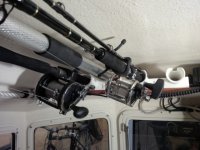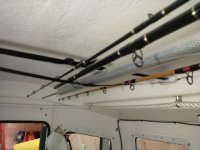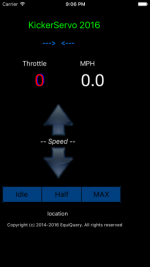Got a few things done over the past couple days.
1) Engine maintenance on my Yamaha 80. This is the first time I've done it vs. a shop. Luckily the local shop where I bought my parts was helpful when I had a snag or two, so I successfully changed the engine oil and filter, and the lower unit oil (which looked clean and no sign of water). I'll detail the "couple of things" here in case it might help anyone else.
a) I could NOT get the oil filter off. I had a large "scissor" type oil filter wrench that has worked great on all my vehicles, but no go on the boat. I saw Yamaha had a cap type one that took a socket drive, so I popped into the local dealer to buy one. He instead loaned me his, saying it would very likely slip, and then also loaned me his HUGE channel lock type plyers (that were not only very large but had notched angles in the "blades").
Sure enough, the Yamaha official oil filter remover just slipped right off (the oil filter laughed). Even with the huge plyers, I had to absolutely mangle the filter (luckily the grippy notches in the plyer blades worked). But it finally came off, and no harm done. I did use the Yamaha filter cap with a torque wrench to torque the new one to EXACTLY Yamaha's spec, so I will find out next time if it was put on too tightly or if they just "do that." I did note that although the oil change was an "owner maintenance" item, they had the "take it to your dealer" annotation on the oil filter change. Hmmm....
b) I had a hard time getting the lower unit plugs not to leak. They are an aluminum plug at the top, with a gasket; and a steel one at the bottom (magnetic) with another of the same gasket. Since they have slotted screw heads, it's hard to put much force on them without mangling the heads. I couldn't get them up to Yamaha torque spec, and couldn't get them to stop seeping. Back to the local shop... He said half the time when they get new engines from Yamaha, they go out to the parking lot after a few days (they sell engines on boats) and .... drips under the lower unit. So it's not just me. Anyway, he showed me how he does it. First, a LARGE screwdriver with a square shaft or a hex place on the shaft. Then a wrench on the shaft. Push really hard on screwdriver, then "ooch" the wrench a little bit at a time, compressing the gasket. I went and bought a Big Daddy 3/8" Craftsman screwdriver, then used a spanner on the square shaft (fits 3/8" but my 10mm was longer and also fit, so I used that). Voila, it worked! I was able to get the screws much tighter and stop the seep (I tightened a little at a time, then gave it some time and checked, then did a bit more). I also picked up two new plugs since I had very slightly marred the heads on the old ones. But since I was able to get the old ones tight and they are not mangled, I saved the new ones for spares.
2) Started cleaning up my wiring. This is a bigger job that I'm doing in stages. Stage 1 (after planning of course) was to re-do the start/engine battery and wiring (I needed to be able to tilt the engine to do the work). That's done now. I did the following:
a) Cut 9' engine cables (6AWG) down to just what was needed to get into the lazarette and have a little to work with.
b) Ran positive to switch, then to new start battery with fuse at battery.
c) Ran negative to new dual power post, then to start battery.
Other cables will later run from there up to my new house area forward, plus there is a negative feeding a small "lazarette bus" (will be powered from house positive though).
I have made all the main cables for the next stage, which is re-locating the house battery. I have the battery tray made as well, but won't be continuing that until I get back from a friend's place (helping out on a job). I've also "undone" and labeled the mess behind the helm and am planning out the replacement. I enjoy working on wiring, and it's rewarding to have it tidied up and know every inch of it. I can't wait to finish digging in when I get back!





